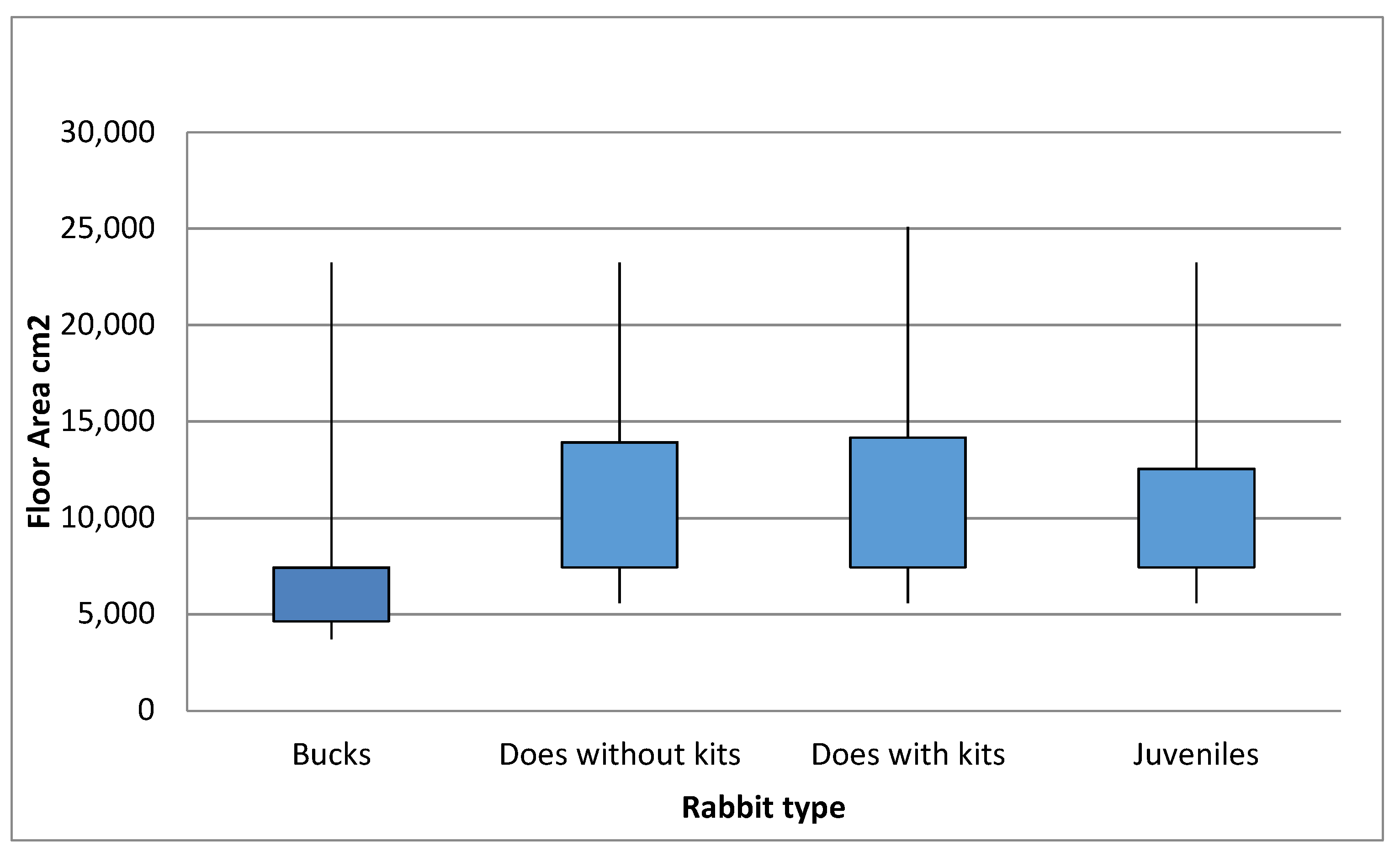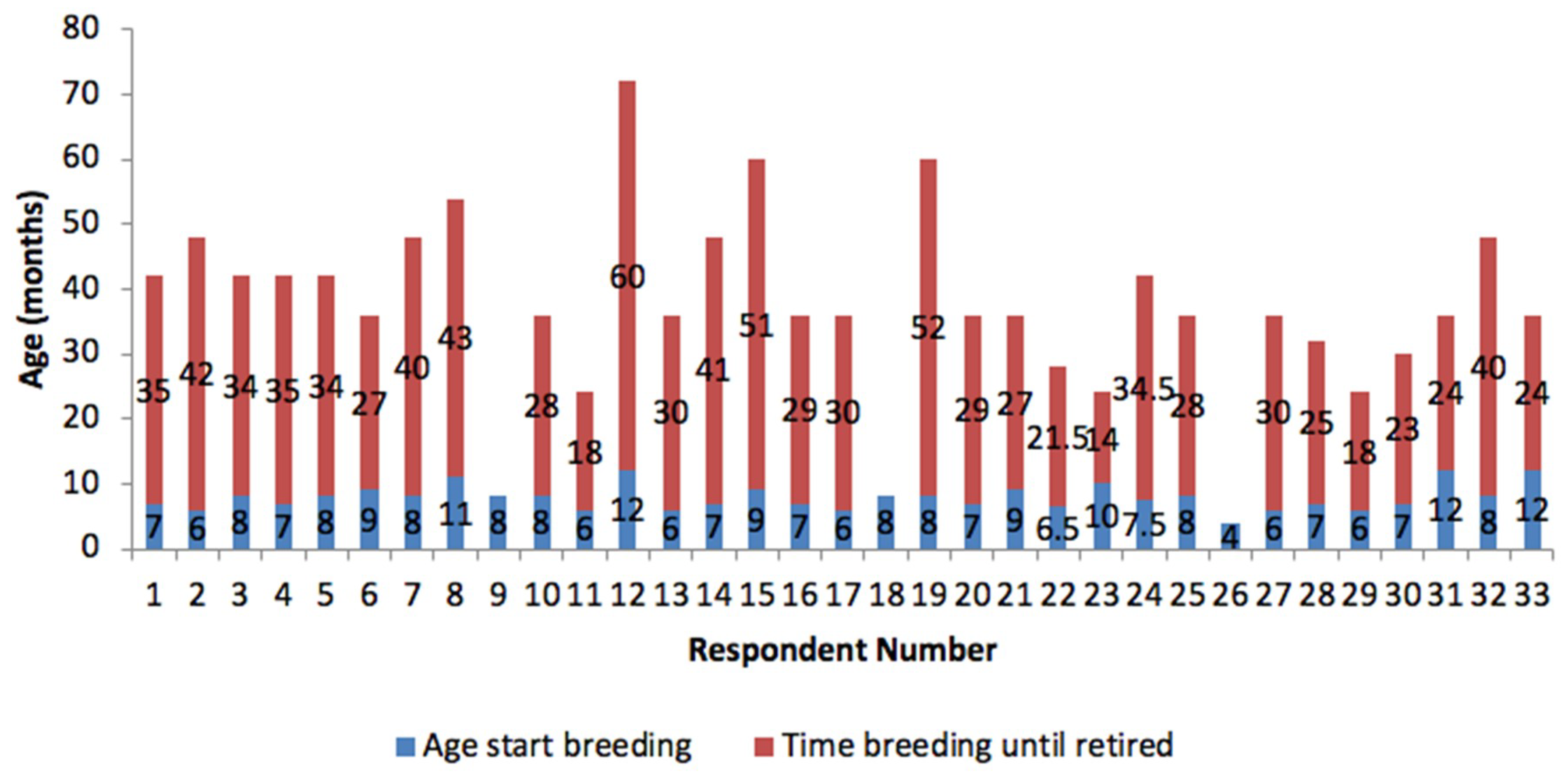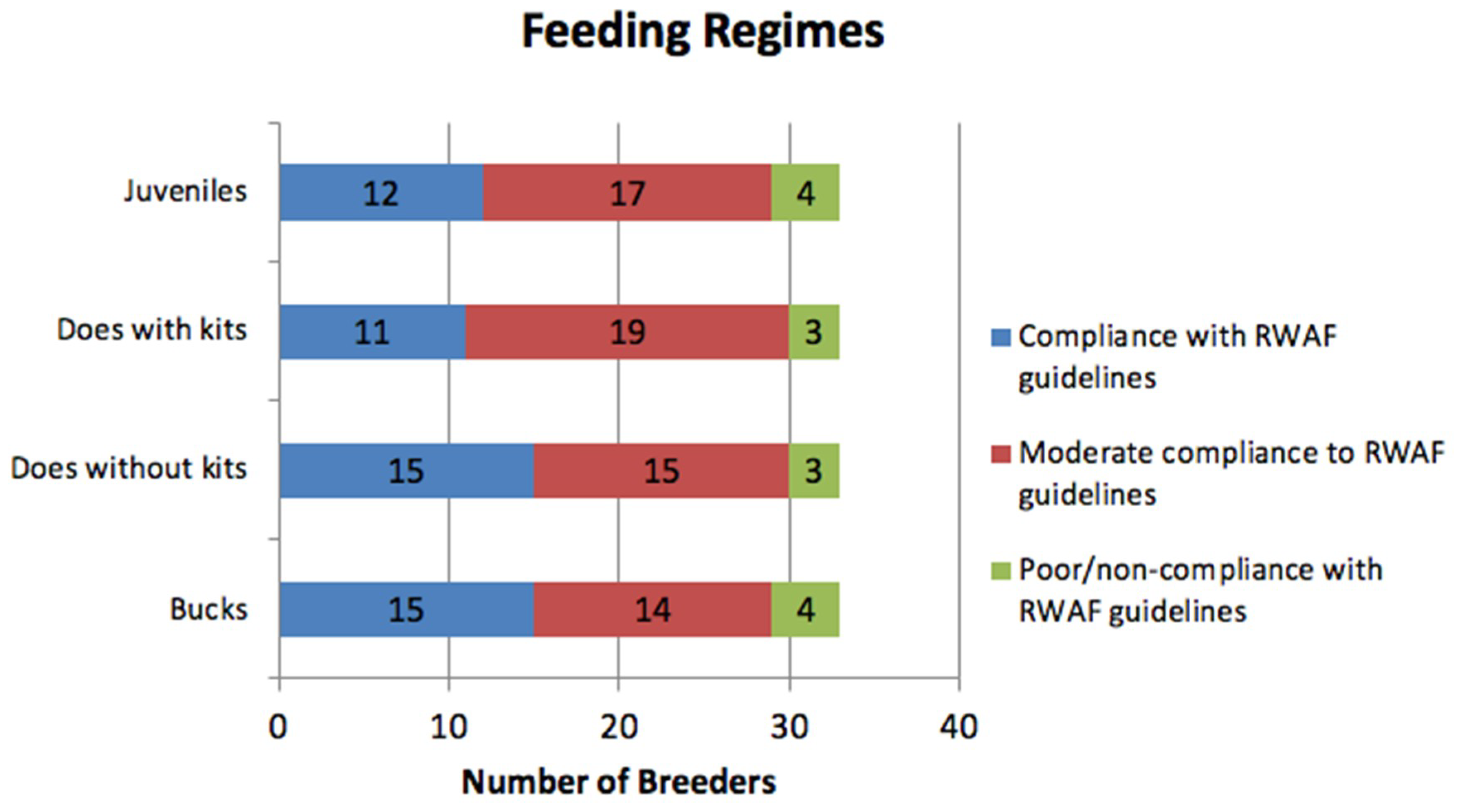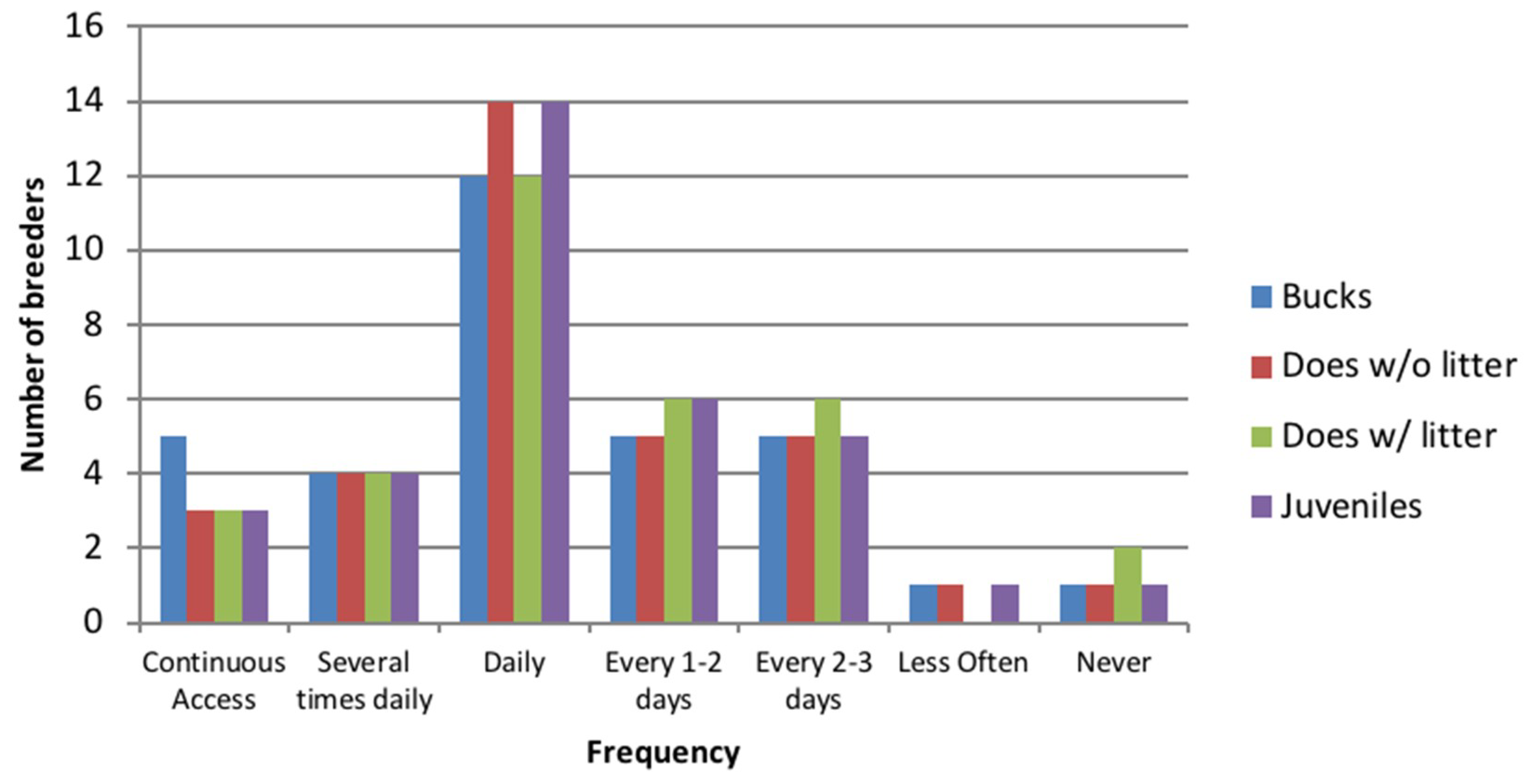The Status of Pet Rabbit Breeding and Online Sales in the UK: A Glimpse into an Otherwise Elusive Industry
Abstract
:Simple Summary
Abstract
1. Introduction
- To identify the most common breeds, location of breeders, vaccination/neuter status at point of sale and self-declared licence information from data gathered from online sale adverts.
- To establish the housing and management conditions of pet rabbit breeding colonies via online questionnaire.
- To establish the consistency of licensing and welfare assessment of UK pet rabbit breeding colonies by local authorities.
2. Materials and Methods
2.1. Council Pet Shop Licenses
2.2. Rabbits Sold Online
2.3. Rabbit Breeder Questionnaire
Data Analysis
3. Results
3.1. Council FOI Requests
Licensing Procedures
3.2. Online Sales
3.3. Rabbit Breeder Questionnaire
3.3.1. Housing and Husbandry
3.3.2. Breeding Does
3.3.3. Kits—Handling and Age Sold
3.3.4. Diet
3.3.5. Exercise
3.3.6. Enrichment
4. Discussion
5. Conclusions
Supplementary Materials
Author Contributions
Funding
Acknowledgments
Conflicts of Interest
Appendix A. Rabbit Breeder Questionnaire
| Housing and Husbandry of Breeding Rabbits Intended for the Pet Trade |



| Continuous Access | Daily | Every 1–2 Days | Every 2–3 Days | Less Often | Never | |
| Bucks | ☐ | ☐ | ☐ | ☐ | ☐ | ☐ |
| Does (without kits) | ☐ | ☐ | ☐ | ☐ | ☐ | ☐ |
| Does (with kits) | ☐ | ☐ | ☐ | ☐ | ☐ | ☐ |
| Juvenile Rabbits | ☐ | ☐ | ☐ | ☐ | ☐ | ☐ |
| Continuous Access | Daily | Every 1–2 Days | Every 2–3 Days | Less Often | Never | |
| Bucks | ☐ | ☐ | ☐ | ☐ | ☐ | ☐ |
| Does (without kits) | ☐ | ☐ | ☐ | ☐ | ☐ | ☐ |
| Does (with kits) | ☐ | ☐ | ☐ | ☐ | ☐ | ☐ |
| Weaned kits | ☐ | ☐ | ☐ | ☐ | ☐ | ☐ |
| Daily | Every 1–2 Days | Every 2–3 Days | Weekly | Less Often | |
| Bucks | ☐ | ☐ | ☐ | ☐ | ☐ |
| Does (without kits) | ☐ | ☐ | ☐ | ☐ | ☐ |
| Does (with kits) | ☐ | ☐ | ☐ | ☐ | ☐ |
| Juvenile rabbits | ☐ | ☐ | ☐ | ☐ | ☐ |
Appendix B
| County | Number of Breeder/Frequent Advertisers |
|---|---|
| Bedfordshire | 6 |
| Berkshire | 3 |
| Bridgend | 1 |
| Bristol | 7 |
| Buckinghamshire | 10 |
| Cambridgeshire | 10 |
| Cardiff | 2 |
| Ceredigion | 1 |
| Cheshire | 11 |
| Clwyd | 1 |
| Conwy | 1 |
| Cornwall | 6 |
| County Durham | 11 |
| Cumbria | 3 |
| Derbyshire | 28 |
| Devon | 9 |
| Dorset | 9 |
| Dumfriesshire | 2 |
| East Riding of Yorkshire | 6 |
| East Sussex | 9 |
| Essex | 44 |
| Fife | 2 |
| Gloucestershire | 13 |
| Greater Manchester | 18 |
| Gwynedd | 1 |
| Hampshire | 25 |
| Herefordshire | 3 |
| Hertfordshire | 8 |
| Kent | 33 |
| Lanarkshire | 3 |
| Lancashire | 17 |
| Leicestershire | 17 |
| Lincolnshire | 16 |
| Merseyside | 11 |
| Middlesex | 7 |
| Midlothian | 1 |
| Monmouthshire | 2 |
| Neath Port Talbot | 2 |
| Newport | 2 |
| Norfolk | 9 |
| North London | 2 |
| North West London | 1 |
| North Yorkshire | 17 |
| Northamptonshire | 5 |
| Northumberland | 2 |
| Nottinghamshire | 24 |
| Oxfordshire | 2 |
| Powys | 2 |
| Rhondda Cynon Taf | 1 |
| Rutland | 1 |
| Shropshire | 2 |
| Somerset | 18 |
| South East London | 3 |
| South Yorkshire | 24 |
| Staffordshire | 21 |
| Suffolk | 11 |
| Surrey | 17 |
| Swansea | 2 |
| Torfaen | 1 |
| Tyne and Wear | 9 |
| Warwickshire | 3 |
| West Lothian | 3 |
| West Midlands | 43 |
| West Sussex | 9 |
| West Yorkshire | 26 |
| Wiltshire | 12 |
| Worcestershire | 16 |
| Total | 646 |
References
- PDSA (Peoples Dispensary for Sick Animals) PDSA ANIMAL WELLBEING (PAW) REPORT, 2018. Available online: https://www.pdsa.org.uk/media/4371/paw-2018-full-web-ready.pdf (accessed on 23 August 2018).
- PDSA (Peoples Dispensary for Sick Animals) PDSA ANIMAL WELLBEING (PAW) REPORT, 2016. Available online: https://www.pdsa.org.uk/media/2627/pdsa-paw-report-2016-printable.pdf (accessed on 23 August 2018).
- Rooney, N.J.; Blackwell, E.J.; Mullan, S.M.; Saunders, R.; Baker, P.E.; Hill, J.M.; Sealey, C.E.; Turner, M.J.; Held, S.D.E. The current state of welfare, housing and husbandry of the English pet rabbit population. BMC Res. Notes 2014, 7, 942. [Google Scholar] [CrossRef] [PubMed]
- Baumans, V. Environmental enrichment for laboratory rodents and rabbits: Requirements of rodents, rabbits, and research. ILAR J. 2005, 46, 162–170. [Google Scholar] [CrossRef] [PubMed]
- Welsh Assembly Government. Code of Practice for the Welfare of Rabbits Following the Code; Welsh Assembly Government: Cardiff, Wales, 2009; ISBN 9780750453561. [Google Scholar]
- The Scottish Government. Pet Rabbit Welfare Guidance; The Scottish Government: Edinburgh, Scotland, 2018; ISBN 978-1-78851-627-3. [Google Scholar]
- Rabbit Welfare Association & Fund Basic Rabbit Set Up. Available online: http://www.rabbitwelfare.co.uk/pdfs/Basic20rabbit20set20up%5B1%5D.pdf (accessed on 10 October 2018).
- Home Office. Code of Practice for the Housing and Care of Animals Bred, Supplied or Used for Scientific Purposes; Home Office: London, UK, 2014; ISBN 9781474112390. [Google Scholar]
- DEFRA (Department for Environment Food and Rural Affairs) Rabbits: Code of Recommendations for the Welfare of Livestock (PB0080). Available online: http://adlib.everysite.co.uk/adlib/defra/content.aspx?id=124623 (accessed on 10 October 2018).
- Her Majesty’ Stationery Office. Animal Welfare Act 2006; Her Majesty’ Stationery Office: London, UK, 2006. [Google Scholar]
- Oxley, J.A. Letter—Rabbit welfare and legislation in the UK. World Rabbit Sci. 2013, 21, 271–272. [Google Scholar] [CrossRef]
- Kurtycz, L.M.; Wagner, K.E.; Ross, S.R. The Choice to Access Outdoor Areas Affects the Behavior of Great Apes. J. Appl. Anim. Welf. Sci. 2014, 17, 185–197. [Google Scholar] [CrossRef] [PubMed]
- Owen, M.A.; Swaisgood, R.R.; Czekala, N.M.; Lindburg, D.G. Enclosure choice and well-being in giant pandas: Is it all about control? Zoo Biol. 2005, 24, 475–481. [Google Scholar] [CrossRef]
- Schapiro, S.J.; Lambeth, S.P. Control, Choice, and Assessments of the Value of Behavioral Management to Nonhuman Primates in Captivity. J. Appl. Anim. Welf. Sci. 2007, 10, 39–47. [Google Scholar] [CrossRef] [PubMed]
- Laura, M.K. Choice and control for animals in captivity. Psychologist 2015, 28, 892–895. [Google Scholar]
- Hazel, S.; Jenvey, C.; Tuke, J.; Hazel, S.J.; Jenvey, C.J.; Tuke, J. Online Relinquishments of Dogs and Cats in Australia. Animals 2018, 8, 25. [Google Scholar] [CrossRef] [PubMed]
- Neville, V.; Hinde, K.; Line, E.; Todd, R.; Saunders, R.A. Rabbit relinquishment through online classified advertisements in the United Kingdom: When, why, and how many? J. Appl. Anim. Welf. Sci. 2018. [Google Scholar] [CrossRef] [PubMed]
- Pet shop Licence (England, Scotland, Wales)—GOV.UK. Available online: https://www.gov.uk/pet-shop-licence (accessed on 10 October 2018).
- Local Government Facts and Figures|LGIU: Local Government Information Unit. Available online: https://www.lgiu.org.uk/local-government-facts-and-figures/#how-many-councils-are-there (accessed on 10 October 2018).
- Wickham, H. Rvest: Easily Harvest (Scrape) Web Pages; The R Foundation: Vienna, Austria, 2016. [Google Scholar]
- Braun, V.; Clarke, V. Using thematic analysis in psychology. Qual. Res. Psychol. 2006, 3, 77–101. [Google Scholar] [CrossRef] [Green Version]
- Ellis, C.F.; McCormick, W.; Tinarwo, A. Analysis of Factors Relating to Companion Rabbits Relinquished to Two United Kingdom Rehoming Centers. J. Appl. Anim. Welf. Sci. 2017, 20, 230–239. [Google Scholar] [CrossRef] [PubMed]
- Vaccinations for Rabbits—PDSA (Peoples Dispensary for Sick Animals). Available online: https://www.pdsa.org.uk/taking-care-of-your-pet/looking-after-your-pet/rabbits/vaccinations-for-rabbits?_$ja=tsid:67827%7Ccid:843703916%7Cagid:44987503658%7Ctid:kwd-296691476320%7Ccrid:222191974002%7Cnw:g%7Crnd:9684020840030548219%7Cdvc:c%7Cadp:1t1%7Cmt:b (accessed on 22 August 2018).
- The Animal Welfare (Licensing of Activities Involving Animals) (England) Regulations 2018. Available online: https://www.legislation.gov.uk/ukdsi/2018/9780111165485/pdfs/ukdsi_9780111165485_en.pdf (accessed on 10 October 2018).
- Stauffacher, M. Social contacts and relationships in domestic rabbits kept in a restrictive artificial environment. In Ethology of Domestic Animals; Nichelmann, M., Ed.; Privat, I.E.C: Toulouse, France, 1986; pp. 100–106. [Google Scholar]
- Hay! The Grass Roots—Rabbit Welfare Association; Fund (RWAF). Available online: https://rabbitwelfare.co.uk/rabbit-diet/hay-grass/ (accessed on 10 October 2018).
- Voris, H.C.; Wittum, T.E.; Rajala-Schultz, P.J.; Lord, L.K. Characterization of advertisements for puppies sold online: Determinants of cost and a comparison with parent club breeders. Prev. Vet. Med. 2011, 100, 200–209. [Google Scholar] [CrossRef] [PubMed]
- Packer, R.M.A.; Hendricks, A.; Tivers, M.S.; Burn, C.C. Impact of Facial Conformation on Canine Health: Brachycephalic Obstructive Airway Syndrome. PLoS ONE 2015, 10, e0137496. [Google Scholar] [CrossRef] [PubMed] [Green Version]
- Kernot, H. Charities Highlight Brachycephaly in Rabbits and Cats. Available online: https://www.vettimes.co.uk/news/charities-highlight-brachycephaly-in-rabbits-and-cats/ (accessed on 8 June 2018).
- Farnworth, M.J.; Chen, R.; Packer, R.M.A.; Caney, S.M.A.; Gunn-Moore, D.A. Flat Feline Faces: Is Brachycephaly Associated with Respiratory Abnormalities in the Domestic Cat (Felis catus)? PLoS ONE 2016, 11, e0161777. [Google Scholar] [CrossRef] [PubMed]
- Harcourt-Brown, F. Dental disease in pet rabbits 1. Normal dentition, pathogenesis and aetiology. Practice 2009, 31, 370–379. [Google Scholar] [CrossRef]
- Siriporn, B.; Weerakhun, S. How to prevent dental disease in rabbit; risk factor in dental disease. Thai J. Vet. Med. 2017, 47, 135–137. [Google Scholar]
- Csomos, R.; Bosscher, G.; Mans, C.; Hardie, R. Surgical Management of Ear Diseases in Rabbits. Vet. Clin. N. Am. Exot. Anim. Pract. 2016, 19, 189–204. [Google Scholar] [CrossRef] [PubMed]
- Podberscek, A.L.; Blackshaw, J.K.; Beattie, A.W. The behaviour of group penned and individually caged laboratory rabbits. Appl. Anim. Behav. Sci. 1991, 28, 353–363. [Google Scholar] [CrossRef]
- Chu, L.; Garner, J.P.; Mench, J.A. A behavioral comparison of New Zealand White rabbits (Oryctolagus cuniculus) housed individually or in pairs in conventional laboratory cages. Appl. Anim. Behav. Sci. 2004, 85, 121–139. [Google Scholar] [CrossRef]
- Harcourt-Brown, F.M. The Progressive Syndrome of Acquired Dental Disease in Rabbits. J. Exot. Pet Med. 2007, 16, 146–157. [Google Scholar] [CrossRef]
- Meredith, A. The BRC Guide to the Importance of Diet in Rabbits; The British Rabbit Council: Nottingham, UK, 2018. [Google Scholar]
- Newberry, R.C. Environmental enrichment: Increasing the biological relevance of captive environments. Appl. Anim. Behav. Sci. 1995, 44, 229–243. [Google Scholar] [CrossRef]
- Pet Animals Act, 1951. Available online: https://www.legislation.gov.uk/ukpga/1951/35/pdfs/ukpga_19510035_en.pdf (accessed on 10 October 2018).
- Pet Shop Licence|Denbighshire County Council. Available online: https://www.denbighshire.gov.uk/en/business/licences-and-permits/animal-licences/pet-shop-licence.aspx (accessed on 10 October 2018).
- RWAF Capone Campaign—Rabbit Welfare Association & Fund (RWAF). Available online: https://rabbitwelfare.co.uk/campaigns/capone-campaign/ (accessed on 16 October 2018).




© 2018 by the authors. Licensee MDPI, Basel, Switzerland. This article is an open access article distributed under the terms and conditions of the Creative Commons Attribution (CC BY) license (http://creativecommons.org/licenses/by/4.0/).
Share and Cite
Gosling, E.M.; Vázquez-Diosdado, J.A.; Harvey, N.D. The Status of Pet Rabbit Breeding and Online Sales in the UK: A Glimpse into an Otherwise Elusive Industry. Animals 2018, 8, 199. https://doi.org/10.3390/ani8110199
Gosling EM, Vázquez-Diosdado JA, Harvey ND. The Status of Pet Rabbit Breeding and Online Sales in the UK: A Glimpse into an Otherwise Elusive Industry. Animals. 2018; 8(11):199. https://doi.org/10.3390/ani8110199
Chicago/Turabian StyleGosling, Emma M., Jorge A. Vázquez-Diosdado, and Naomi D. Harvey. 2018. "The Status of Pet Rabbit Breeding and Online Sales in the UK: A Glimpse into an Otherwise Elusive Industry" Animals 8, no. 11: 199. https://doi.org/10.3390/ani8110199





